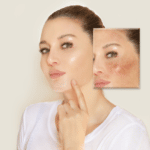Have you noticed a slight patch of skin discoloration on your face? Or a couple of blotches that are a shade or two darker from your actual skin color?
If yes, you might be developing melasma, also loosely known as the “mask of pregnancy.” While pregnant women are more likely to get it, anyone can suffer from melasma. In general, women are more likely to experience melasma. Men are less likely to get it — only 10% of people who have melasma are men.
Before you start worrying, let us clear one thing — melasma is not dangerous from a health perspective. However, it can impact one’s appearance and affect their confidence.
If you are wondering how and why you experience melasma and how you can get rid of it, keep reading. We have covered everything you need to know about melasma here.
What is Melasma?

Melasma is a common skin pigmentation disorder that causes dark brown or blue-gray patches or freckle-like spots on your skin. Since these patches are darker than your skin tone, they are visible on the skin.
These dark patches — also known as hyperpigmentation — tend to show on the face, mainly on the forehead, cheeks, and the upper lip. It is unlikely, but it can also crop up on the back, neck, forearms, or any other body part exposed to direct sunlight.
It is also the reason why melasma symptoms worsen during the hot months. It generally impacts individuals with light brown skin to darker skin tones, especially in areas with high sun exposure. Fair-skinned people are less likely to be affected by melasma.
As indicated above, pregnant women are at greater risk of developing melasma — 15% to 50% of pregnant women experience it. It happens more often during a woman’s reproductive years and rarely during puberty, which is between 20 and 40 years of age.
Melasma is also known as chloasma. However, it is a lesser-known name.
8 Causes of Melasma

The short and direct answer is no one knows. Researchers know that when someone has melasma, the cells that give skin its color (melanocytes) tend to be more active. However, there is no concrete answer to why it happens. All we know is that melasma develops because of a combination of hormones, sun exposure, and genetics.
Let’s have a look at all the possible reasons why you may develop melasma –
1. Radiation
Radiation may include ultraviolet, visible light, or infrared (heat) light.
Some of the most common reasons for the appearance of melasma are sun and light exposure. Our skin has pigment-producing cells called melanocytes to produce more pigment. UV light from the sun and visible light from light bulbs can stimulate those cells. Those who have brown or black skin have more melanocytes in their skin.
Even small amounts of light exposure, such as driving in a car or walking in a parking lot to a store, can induce melasma. Use a sunscreen that protects against both ultraviolet A and ultraviolet B radiation. The sunscreen should have a sun protection factor (SPF) of at least 30. Also, cover your exposed skin with a scarf or wear a hat with a brim to protect or shade your face.
Melasma may also be caused by the LED lights from your television, laptop, cell phone, and tablet. Try to limit their usage.
2. Hormones
Hormones like estrogen and progesterone are well-known melasma triggers. However, the connection behind it is still not understood.
As stated above, women develop melasma more frequently than men. One of the reasons behind this is that women have higher levels of estrogen in their bodies naturally.
Individuals with melasma have high numbers of progesterone receptors in the affected areas of the skin, which suggests that their skin is sensitive to increased progesterone levels.
Moreover, postmenopausal women are sometimes given progesterone and have been observed developing melasma.
3. Pregnancy
Melasma is not known as “the mask of pregnancy” for no reason. Both pregnancy and hormonal birth control increase the amount of estrogen in the body. The increased levels of estrogen, progesterone, and melanocyte-stimulating hormones during the third trimester of pregnancy play a substantial role in worsening the melasma symptoms.
4. Stress
There is no direct connection between stress and melasma. Psychological stress is not even a skin irritant. However, stress increases a hormone called cortisol in your body, which can, in turn, influence the amount of estrogen in your body. The increased estrogen levels, as established above, can cause melasma.
5. Medications
There are a few medications that may trigger melasma in some people –
- Drugs that prevent you from having seizures may be a cause of melasma.
- Oral contraceptive pills contain estrogen and progesterone and can cause melasma.
- Phototoxic drugs, such as retinoids, nonsteroidal anti-inflammatory drugs (NSAIDs), diuretics, some antibiotics, and some blood pressure medications, may make your skin more sensitive to sunlight, which is a root cause of melasma.
6. Thyroid
The thyroid gland releases a substance called ‘thyroxine’. It plays a crucial role in the proper functioning of many cells in your body, including your muscles, heart, digestive system, hair, and skin.
While there are still studies being conducted, 20.3% of people that have melasma have thyroid dysfunction.
7. Genetics
If you have a family history of melasma, you are highly likely to develop it. Approximately 50% report a positive family history of the condition. The chances are even higher than usual when you have an identical twin having the same skin condition.
8. Skincare products
A product that irritates your skin, in general, will likely make your melasma worse. Skin irritants include certain fragrances, soaps, and cosmetics. Many people use cosmetics to hide the dark patches of melasma. Be careful and choose products that are gentle on your skin and unscented.
You can also consult your dermatologist before buying products.
If you’re conscious about your skin discoloration, visit a skin care specialist. You can also join local support groups or meet counselors to regain your lost confidence.
More resources on Melasma:



